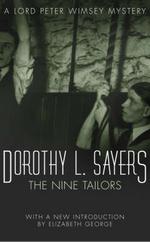Dorothy Sayers wrote early in the era of detective fiction and helped to establish the borders of the genre. Her Lord Peter Wimsey stories follow, and help shape a classic cosy formula, an amateur detective who provides the continuity from book to book, a small enclosed community with lots of fascinating detail, and into that community the horrible disruption of murder, turning everyone into suspects. Sayers’s genius was to write a pile of stories on this model, all very neat with elegant solutions, and then to make her cardboard hero real and write a couple of real novels in the series with heart and depth. These last two, Gaudy Night and Busman’s Honeymoon, deserve to be read after the others to be truly appreciated.
I came to Sayers very late, about ten years ago. I read Agatha Christie and Josephine Tey’s cosies as a teenager, but I found the British Sayers covers that were then current quite repellent, and also in a kind of reverse snobbery felt I didn’t much care to read about a lord solving mysteries. This idiocy deprived me of some excellent books for a long time. I eventually decided to read them after being thoroughly spoiled for Gaudy Night by Connie Willis’s To Say Nothing of the Dog. The spoiler—and I suppose I can forgive Willis for spoiling a sixty year old classic—was enticing. I asked for reading order, and Pamela Dean gave me the very wise advice that the books start with Whose Body, but the best one to start with if I wanted to know whether I liked them was the entirely stand alone Nine Tailors.
In Nine Tailors, Lord Peter gets stranded in a little fenland village and helps the village to ring an all night peal of bells on New Year’s Eve. Months later—the events of the book cover a year—a body is discovered in a grave, and not the body that’s supposed to be there. Lord Peter is called back to investigate. The book takes in snow, floods, the drainage of the fens, bell ringing, a missing necklace, bigamy, murder, a village idiot, church architecture, and in the end a very neat solution to the mystery.
Mysteries are, like science fiction, very dependent on the tech level at which they are set. The techniques available for autopsies, the possibilities of blood typing, of DNA evidence, the whole paraphernalia of detection depends utterly on the technology of the time. Reading an old book like this makes one very aware of the limitations of the techniques of the period. Unlike science fiction, you know that at the end of a cosy mystery nothing will really change, everything will get put away in the box again safely.
The thing that I love about cosy mysteries in general is the way there is a small enclosed society that is disrupted by the murder and then restored to order by the solution. I’m also fascinated by the way that they’re about the intrusion of violent death into lives, yet everything always seems so nice. There are cups of tea and bottles of beer and anything and everything may be a clue, but there will be muffins later, brought by a servant who is delighted to serve you, but who may be the butler who Did It. There’s a strange tension there. (This fascination is, naturally, why I deliberately played with all this in my Small Change books.) Nine Tailors is a perfect example of a classic British cosy, with the change ringing and emerald necklace and servants everywhere. Beyond that it’s beautifully written and it has tremendous forces of nature: the great flood, and most of all the huge named bells: Tailor Paul, Batty Thomas, John, Jericho, Gaude, Saboath, Jubilee, Dimity.
It’s a great pleasure to re-read a book like this on a cold day, knowing everyone’s motivations and revisiting the familiar scenes of an orderly universe with just a little uncanniness creeping in at the edges.










